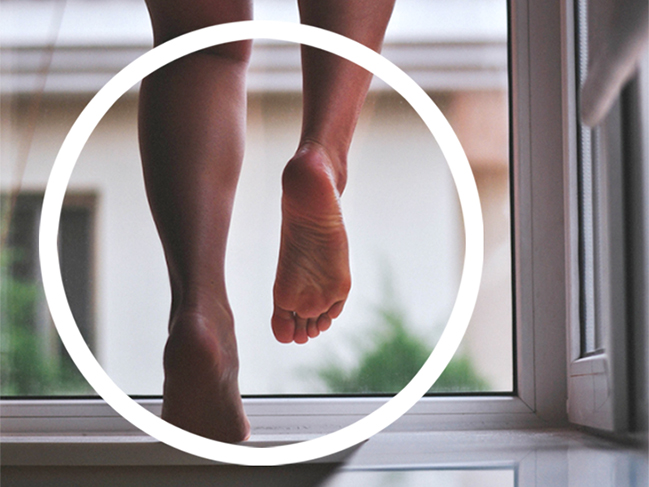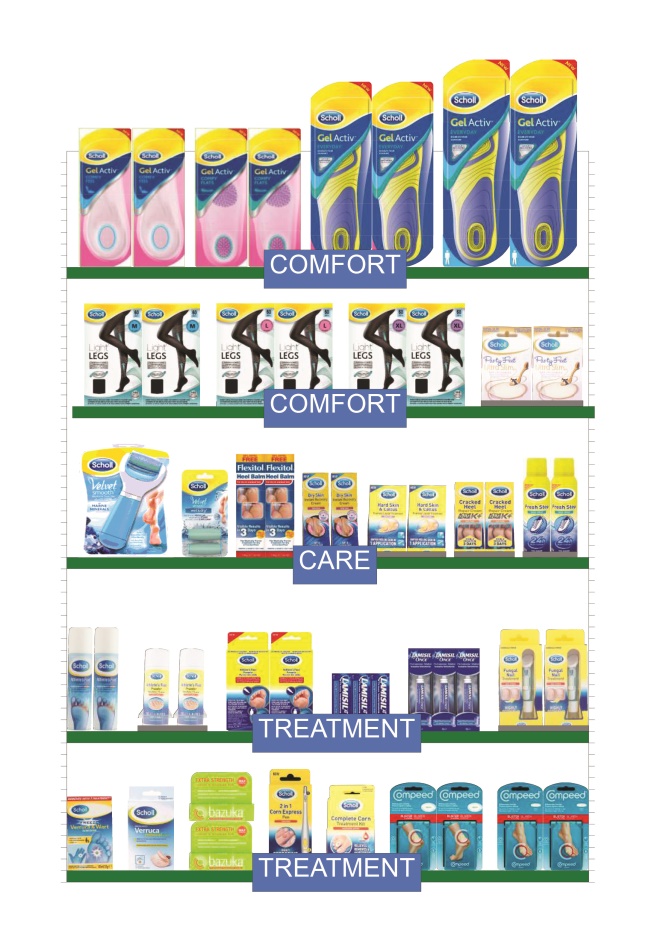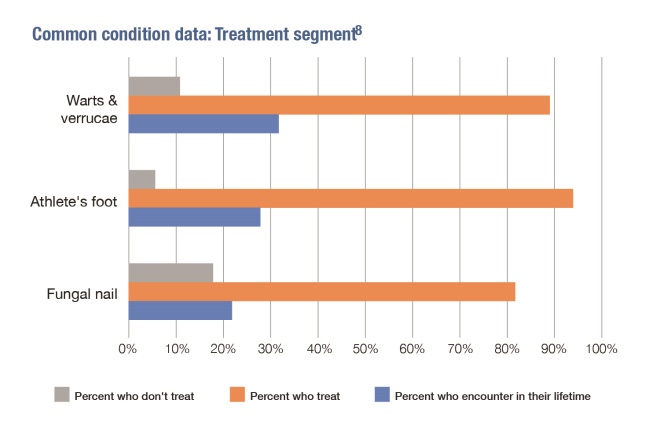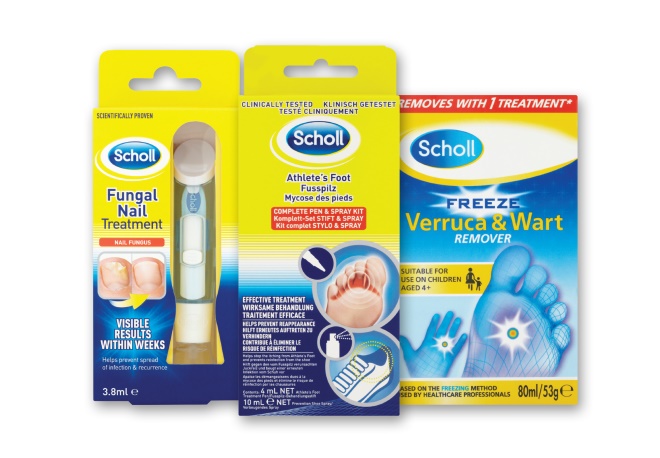
Scholl
We walk around 100,000 miles in our lifetime[1]
, so it’s unsurprising that this can take its toll on our feet and that a large propotion of people experience some form of foot problem[2]
.
Not only is footcare an important category in terms of incidence, but it’s also the third largest OTC category and one of the fastest growing,* currently valued at £118 million[3]
. It represents a significant part of a pharmacy’s retail offering and should be a major focus.
Ensuring the breadth of this category presents an opportunity for pharmacy to showcase its value to patients whilst avoiding potential category confusion requires well trained teams, with enhanced consultation and category management skills.
RB, manufacturer of leading footcare brand Scholl†is committed to helping community pharmacy to achieve the best outcomes for their patients suffering foot conditions. Here we cover some key aspects of training and support that can help pharmacy to identify and treat very common foot problems, to ensure patients’ feet receive the care they need.
Unlocking the clinical opportunity for community pharmacy
Some foot problems, such as dry skin and cracked heels, are skin related plus the pressures of normal day-to-day activity can also cause corns, calluses and blisters due to friction. Skin infections, such as warts and verrucae, and athletes foot as well as fungal nail infections can also cause pain, discomfort, and look unsightly.
Just managing these common conditions requires knowledge across a broad range of conditons and treatments. Giving advice to maintain good foot hygiene is equally essential to help avoid these issues, yet even this can be fraught with problems, for example cutting toenails incorrectly is one of the commonest causes of ingrowing toenails[4]
.
With so many potential foot problems caused by a variety of reasons its important for pharmacy to have strong clinical knowledge in footcare to identify the issue, explain the problem to the patient and help with product selection.
Training can unlock potential
Scholl has a long-standing committment to in-store support and training for pharmacy staff on foot conditions to help pharmacy unlock the potential in the footcare category.
Following a successful series of evening training seminars on footcare and marketing in pharmacy, RPS-accredited footcare training modules for pharmacy teams are availalable free online at rbforhealth.co.uk, they cover many common conditions, and include: understanding foot health, and helping customers.
This year the new partnership with The Pharmaceutical Journal has sought to provide even more comprehensive education and to highlight the role pharmacy teams can perform.
Understanding and overcoming the category confusion
A well trained team can add huge value to the patient consultation but the reality is that patients don’t always seek advice and may choose to self select products from the shelf, which is where a well merchandised store could be invaluable to patient experience.
Stocking the right range of products correctly merchandised will maximise the experience for shoppers and ensure pharmacies make the most of this important category. Focusing on footcare should be a priority for all pharmacies, not only to look after their patients and to be seen as a trusted source of local advice on footcare problems, but to ensure they are getting their share of sales in this important category.
Effective merchandising is key

Source: Scholl
Using the Scholl footzone in the pharmacy helps consumers shop more easily and ensures pharmacies make the most of the category.
For people who prefer to self-select, a correctly merchandised fixture is very important to help differentiate between the extensive range of products. This is highlighted by the fact that 22% of shoppers walk away from the shelf empty-handed[5]
.
Implementing the Scholl footzone in the pharmacy that segments the category into three segments: treatment, comfort, and care, helps consumers shop more easily, and consequently, ensures pharmacies make the most of the category.
Effective merchandising can help with range navigation and improve patient experience, however, even if the patient correctly identifies their condition they can still be left confused over which is the most appropriate for them, so the pharmacy’s input can be extremely valuable.
Merchandising tips
- Create a dedicated footzone fixture
- Locate it next to the first aid section
- Merchandise the shelves into: treatment, comfort and care segments using Scholl planograms
- Display a range of Scholl products as they are the beacon brand and will help identify the category
- Consider using signage to clearly identify the fixture — clear signage has been shown to increase purchase intent by 29%[6]
- Consider using pegboards — they have been shown to increase insole sales by 107%[7]
.
Footcare market dynamics
Breaking the category down, into treatment, comfort and care, treatment is a an important and significant segment. The key areas within the treat segment are: fungal nail infection, athletes foot, cracked skin, warts and verrucae[8]
.
- Fungal nail infection, affects 22% of people in their lifetime, yet for whatever reason, 18% don’t treat.
- Athletes’ foot has a higher incidence of 28%, but less surprisingly more people treat, given the discomfort caused by this condition.
- Warts & verrucae has an even higher incidence at 32%, yet with 11% not treating.

Source: Scholl
The footcare category can be broken down into treatment, comfort and care. Treatment is an important segment, which includes fungal nail infection, athlete’s foot, cracked skin, warts and verrucae.
It is clear there is value in stocking a range of products from each of these categories and to help the non-treaters identify their symptoms and choose an appropriate product. For those who do treat, large incidences demonstrate a clear sales opportunity, especially with patients who’ve been assisted on their product selection.

Source: Scholl
Scholl provides products for treating foot conditions, including Scholl Fungal Nail Treatment, Scholl Athlete’s Foot Complete Pen & Spray Kit, and Scholl Freeze Verruca & Wart Remover.
From the treatment range, Scholl’s key products include:
- Scholl Fungal Nail Treatment
- Scholl Athlete’s Foot Complete Pen & Spray Kit
- Scholl Freeze Verruca & Wart Remover
Comfort and care shoppers
Compared to treatment, shoppers currently have lower awareness of comfort-related products including insoles, orthotics, and hosiery. There is an opportunity here for pharmacists and their teams, to educate customers about the benefits of this segment.
The care segment provides consumers with a range of products to enhance foot hygiene and appearance in their own home. Here they can also manage cracked heels, hard skin, toenail care, foot odour, and dry skin. Rough and cracked skin is the second biggest beauty concern, so stocking products to meet this need is an essential part of a pharmacy footcare range[9]
.
Scholl has an unparralleled range of products for treatment, comfort, and care, which puts the brand at forefront of the footcare catregory in the pharmacy, and with patients.
A commitment to expertise and innovation
As experts in footcare with 100 years’ of experience, Scholl continues to be committed to innovation, creating new treatments for footcare problems that can be offered with expert advice. Most recently introduced is our ingrowing toenail kit.** Prior to the launch, the only alternative was to consult a foot specialist or face the potential of undergoing surgery. At the first signs of symptoms, the kit can be used at home to effectively treat this possibly painful condition — another opportunity for pharmacy to provide advice and help alleviate discomfort.
Realising the potential for community pharmacy
Well-trained pharmacy teams can help identify foot conditions, advise on appropriate products and provide information on prevention. Stocking the right range of products correctly merchandised will maximise the experience for shoppers and ensure pharmacies make the most of this important category while providing treatment, comfort and care for people with foot conditions. Focusing on footcare should be a priority for all pharmacies, not only to look after their patients and to be seen as a trusted source of local advice on footcare problems, but to ensure they are getting their share of sales in this important category.
*SOURCE: IRI; All Outlets; Value Sales; 52 w/e 19th March 2016 vs YA
†Source: Nielsen MAT w/e 15.07.17 Total Footcare Value Sales Total Coverage
** Suitable to use when there is pressure between the skin and nail causing discomfort, but not if the nail has pierced the skin.
All adverse events should be reported. Reporting forms and information can be found at www.mhra.gov.uk/yellowcard. Adverse events should also be reported to Reckitt Benckiser Healthcare UK Ltd on 0333 2005 345.
This article has been sponsored, briefed and reviewed by Scholl.
UK/SC/0617/0031f
References
[1] Society of Chiropdoists and Podiatrists. Walking. www.scpod.org/foot-health/shoes-for-sporting-activities/walking/. Last accessed July 2017.
[2] College of Podiatry. Report to determine the current patient population managed by UK podiatrists and the evidence available to support the effectiveness of podiatric contributions to health and wellbeing.
[3] Nielsen Scan track w/e 20/5/17.
[4] Society of Chiropdoists and Podiatrists. Ingrowing Toenail. www.scpod.org/foot-health/common-foot-problems/ingrowing-toenail/. Last accessed July, 2017.
[5] Scholl Independent UA Study 2011.
[6] Source: Nielsen Homescan data - 12 wks Feb - April 2015.
[7] Source: Dunnhumby shop data: 6 week(s) from 20 Apr 2015 to 31 May 2015.
[8] Nielsen MAT M£ Q3 2016
[9] Boots Beauty UA Study


